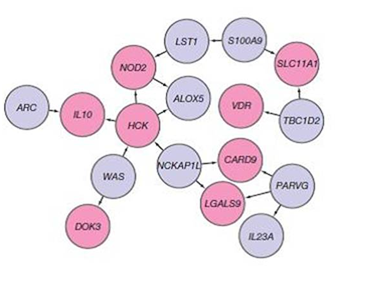|
Clostridium Leptum
''Clostridium leptum'' is a bacterium species in the genus ''Clostridium''. It forms a subgroup of human fecal microbiota. Its reduction relative to other members of the gut microbiota has been observed in patients with inflammatory bowel disease Inflammatory bowel disease (IBD) is a group of inflammation, inflammatory conditions of the colon (anatomy), colon and small intestine, Crohn's disease and ulcerative colitis being the principal types. Crohn's disease affects the small intestine a .... The genome of ''C. leptum'' has been sequenced. References External links Type strain of ''Clostridium leptum'' at Bac''Dive'' - the Bacterial Diversity Metadatabase Gut flora bacteria Bacteria described in 1976 leptum {{Clostridia-stub ... [...More Info...] [...Related Items...] OR: [Wikipedia] [Google] [Baidu] |
Clostridium
''Clostridium'' is a genus of anaerobic, Gram-positive bacteria. Species of ''Clostridium'' inhabit soils and the intestinal tract of animals, including humans. This genus includes several significant human pathogens, including the causative agents of botulism and tetanus. It also formerly included an important cause of diarrhea, ''Clostridioides difficile'', which was reclassified into the ''Clostridioides'' genus in 2016. History In the late 1700s, Germany experienced a number of outbreaks of an illness that seemed connected to eating certain sausages. In 1817, the German neurologist Justinus Kerner detected rod-shaped cells in his investigations into this so-called sausage poisoning. In 1897, the Belgian biology professor Emile van Ermengem published his finding of an endospore-forming organism he isolated from spoiled ham. Biologists classified van Ermengem's discovery along with other known gram-positive spore formers in the genus ''Bacillus''. This classification prese ... [...More Info...] [...Related Items...] OR: [Wikipedia] [Google] [Baidu] |
Inflammatory Bowel Disease
Inflammatory bowel disease (IBD) is a group of inflammation, inflammatory conditions of the colon (anatomy), colon and small intestine, Crohn's disease and ulcerative colitis being the principal types. Crohn's disease affects the small intestine and large intestine, as well as the mouth, esophagus, stomach and the anus, whereas ulcerative colitis primarily affects the colon and the rectum. IBD also occurs in dogs and is thought to arise from a combination of host genetics, intestinal microenvironment, environmental components and the immune system. There is an ongoing discussion, however, that the term "chronic enteropathy" might be better to use than "inflammatory bowel disease" in dogs because it differs from IBD in humans in how the dogs respond to treatment. For example, many dogs respond to only dietary changes compared to humans with IBD, who often need Immunosuppression, immunosuppressive treatment. Some dogs may also need immunosuppressant or antibiotic treatment when dieta ... [...More Info...] [...Related Items...] OR: [Wikipedia] [Google] [Baidu] |
Gut Flora Bacteria
Gut or guts may refer to: Anatomy * Abdomen or belly, the region of a vertebrate between the chest and pelvis * Abdominal obesity or "a gut", a large deposit of belly fat * Gastrointestinal tract or gut, the system of digestive organs * Insect digestive system * Lower gastrointestinal tract or guts, the intestines * To "gut" an animal is part of the butchery process Geography and places * Gut (coastal geography), a narrow coastal body of water * Gut (Crișul Alb), a river in Romania * Gut River, Jamaica * Spring Run (West Branch Susquehanna River), also known as The Gut * The Gut (geological feature), a conservation area east of Apsley, Ontario, Canada People * Gut (surname), list of people named ''Gut'' or ''Guts'' Arts, entertainment, and media Film and television * ''Guts'' (2009 film), a Spanish crime drama * ''Guts'' (1999 film), a Dutch comedy * "Guts" (''The Walking Dead''), a season 1 episode of the television series ''The Walking Dead'' * '' Nickelodeon ... [...More Info...] [...Related Items...] OR: [Wikipedia] [Google] [Baidu] |
Bacteria Described In 1976
Bacteria (; singular: bacterium) are ubiquitous, mostly free-living organisms often consisting of one biological cell. They constitute a large domain of prokaryotic microorganisms. Typically a few micrometres in length, bacteria were among the first life forms to appear on Earth, and are present in most of its habitats. Bacteria inhabit soil, water, acidic hot springs, radioactive waste, and the deep biosphere of Earth's crust. Bacteria are vital in many stages of the nutrient cycle by recycling nutrients such as the fixation of nitrogen from the atmosphere. The nutrient cycle includes the decomposition of dead bodies; bacteria are responsible for the putrefaction stage in this process. In the biological communities surrounding hydrothermal vents and cold seeps, extremophile bacteria provide the nutrients needed to sustain life by converting dissolved compounds, such as hydrogen sulphide and methane, to energy. Bacteria also live in symbiotic and parasitic relationships wit ... [...More Info...] [...Related Items...] OR: [Wikipedia] [Google] [Baidu] |

